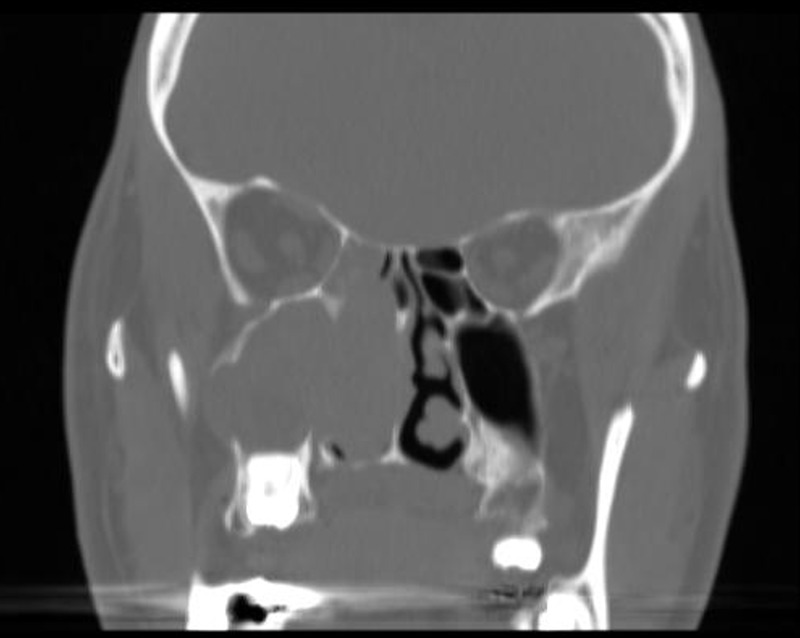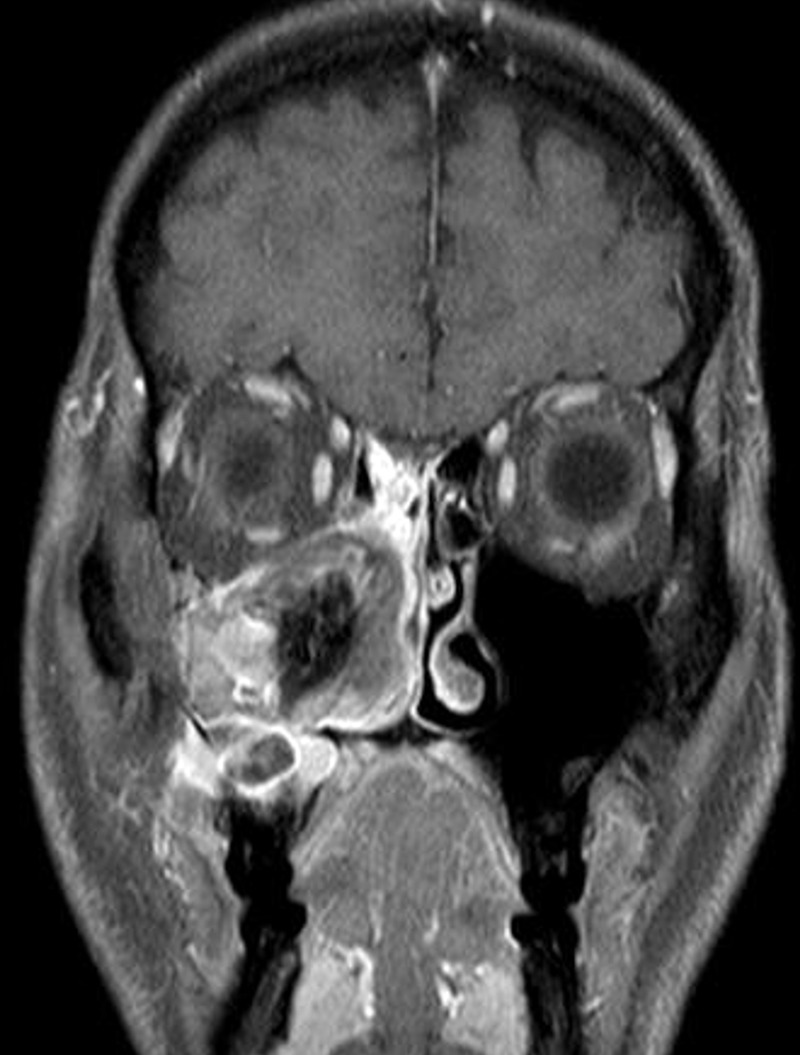Description
A 46-year-old man was referred to our ear nose throat clinic for the right nasal obstruction, purulent nasal discharge, mid-facial swelling and upper right gingival retraction since 6 months. He had previously received antibiotic therapy with temporary relief. Nasal endoscopy showed medialisation of the right uncinate process, while the oral examination revealed a swelling of the upper right alveolar arch. The head CT (figure 1) showed an expansive mass occupying the right maxillary sinus. The suspicion of neoplastic disease led to perform an MRI with contrast medium (figure 2). Despite the high suspicion of fungal disease after MRI, which showed a fungal-like central signal void, the patient underwent an explorative endoscopic procedure to rule out a neoplastic condition.
Figure 1.

Coronal CT scan of the paranasal sinuses showing an expansive mass of the right maxillary sinus. The mass erodes the inferior, medial and lateral walls of the sinus and an ethmoidal involvement was observed.
Figure 2.

Coronal T1-weighted MRI of the paranasal sinuses showing an expansive mass of the right maxillary sinus characterised by the lack of tissue infiltration and contrast enhancement with a markedly dishomogenous signal. MRI identified three components of the mass, a mucosal thickening of the right maxillary and ethmoidal sinuses (suggesting an inflammatory reaction), a maxillary signal void (suggesting a fungal disease), and a maxillary odontogenic cyst, which was already known to the patient.
The intraoperative examination excluded malignancies and the procedure was completed with a wide middle antrostomy that allowed toileting the mixed necrotic and fungal-like material occupying the sinus. The known odontogenic cyst—the likely odontogenic focus—was also removed endoscopically. The histopathological examination resulted in actinomycosis and the patient recovered after long-term antibiotic therapy (intravenous ceftriaxone 2 g four times a day for 1 month, followed by oral amoxicillin clavulanate 1 g three times a day for 3 months). There was no relapse during the 1-year follow-up.
Actinomycosis is a rare condition with frequent cervicofacial involvement caused by Actinomyces spp.1 In case of sinonasal involvement, the unresponsiveness to antibiotic therapy alone requires thorough surgical debridement.2 As for all odontogenic sinonasal conditions presenting no signs of oroantral fistulae, this case was treated according to the literature with nasal endoscopy and long-term antibiotics.3
Learning points.
Despite its rarity, actinomycosis should be taken into differential diagnosis when imaging studies show an expansive mass with significant bony erosion.
Always examine patients' dental history when addressing sinonasal conditions, no matter how unrelated to dental treatments may they appear.
While the surgical treatment of actinomycosis is similar to the other odontogenic sinonasal diseases, long-term antibiotic treatment is required to achieve complete recovery.
Footnotes
Contributors: CP and GF performed the surgical procedure. AMS and DDP retrieved data and images and wrote the article.
Competing interests: None.
Patient consent: Obtained.
Provenance and peer review: Not commissioned; externally peer reviewed.
References
- 1.Vorasubin N, Wu AW, Day C, et al. Invasive sinonasal actinomycosis: case report and literature review. Laryngoscope 2013;2013:334–8 [DOI] [PubMed] [Google Scholar]
- 2.Woo HJ, Bae CH, Song SY, et al. Actinomycosis of the paranasal sinus. Otolaryngol Head Neck Surg 2008;2013:460–2 [DOI] [PubMed] [Google Scholar]
- 3.Felisati G, Chiapasco M, Lozza P, et al. Sinonasal complications resulting from dental treatment: outcome-oriented proposal of classification and surgical protocol. Am J Rhinol Allergy 2013;2013:101–6 [DOI] [PubMed] [Google Scholar]


